Top 7 Views in Death Valley National Park
As the largest national park in the contiguous United States, Death Valley National Park has plenty of attractions and activities to offer. You could spend several days, even weeks, exploring this vast park.
Some of the most popular things to do include hiking, sightseeing, stargazing, enjoying the many spectacular views in Death Valley National Park, and even bird watching.
If you’re looking for the most scenic Death Valley views, you’ll find them below.
Most of these viewpoints in Death Valley National Park are major highlights in the park, overlooking famous landscapes and unique natural features, and/or offering great hiking opportunities.
I’ve made this a “top” list, but, of course, this ranking is highly subjective. You might disagree with the actual order of these Death Valley views, but I’m pretty sure that you would agree that all these places belong on this list.
They’re must-sees in Death Valley National Park, the “hottest, driest and lowest” of all national parks in the United States.
This blog post about the greatest views in Death Valley National Park contains affiliate links. You can read more about our Terms of Use / Disclosure here.
Top 7 Scenic Views in Death Valley National Park
7. Devils Golf Course
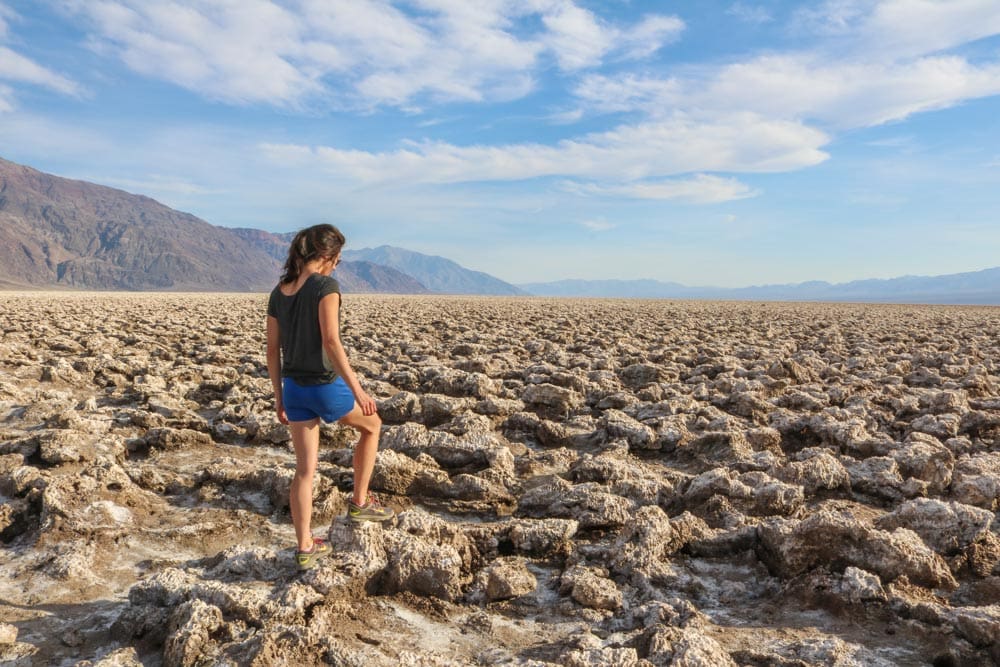
Although not a particularly breathtaking sight, I do consider Devil’s Golf Course to have its place among these other Death Valley National Park views.
I personally like this area a lot because it looks incredible in the late afternoon. With the sun low in the sky, the remarkable halite salt crystal formations in this huge salt pan cast countless wonderful shadows across the desert floor.
The remarkable landscape is made up of literally thousands of serrated salt rocks, eroded away by water and wind, some as sharp as a knife. You can walk over and among them, but make sure to wear sturdy shoes and be careful. If you trip, you’re certain to get hurt—those rocks are razor-sharp.
These extraordinary features are the reason behind this area’s interesting name. It was said that “only the devil could play golf” there.
6. Artists Palette
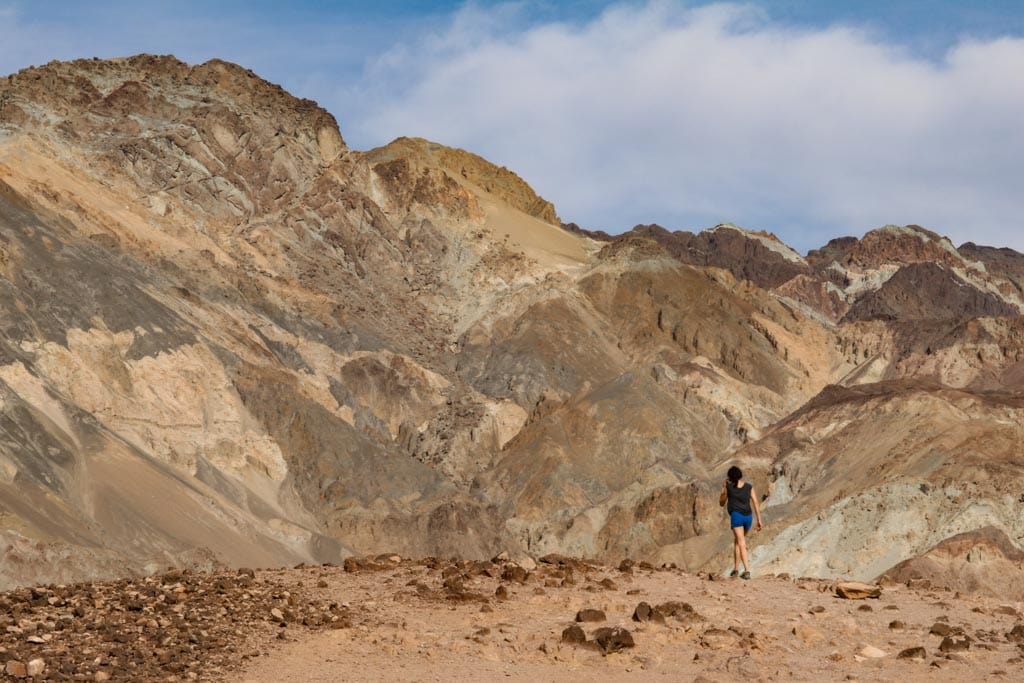
Located along the Artists Drive Scenic Loop, which is about halfway between Furnace Creek and Badwater Basin, Artists Palette is a marvelous collection of kaleidoscopically colored hills.
These vibrant colors—from yellow, orange, and red to green, blue, and pink—come from volcanic deposits that are rich in iron oxide, chlorite, and other compounds.
Although there are no hiking trails here, a number of roadside pullouts provide the opportunity to admire this rainbow of colors from up-close.
Artists Palette is stunning any time of day, but I’d recommend visiting this area at sunrise or sunset when the low angle of the sun creates contrasting shadows and beautifully shifting light across the hills.
5. Harmony Borax Works

For one of the most historic panoramic views in Death Valley National Park, head to Harmony Borax Works near Furnace Creek.
A rich borax mine in the late-1800s, Harmony Borax Works was instrumental in opening up Death Valley to pioneers, traders, workers and, later, tourists. In its heyday, Harmony Borax Works employed 40 men.
Besides sustaining a team of miners in such a hot and arid place, one of the biggest challenges of operating a mine in the middle of a sprawling desert was getting your product out to the market.
Harmony Borax Works figured it out and became renowned for its large mule teams and double wagons. These hardy animals and men traveled the long overland road to Mojave, the location of the nearest railroad station.
Harmony Borax Works’ “twenty-mule teams” became a symbol of the mining operations in Death Valley.
Nowadays, you can visit the remains of the Harmony Borax Works plant and walk a short interpretative trail that takes you around the mine and past an old mule wagon, while the park’s hills and mountains rise up in the distance.
4. Mesquite Flat Sand Dunes
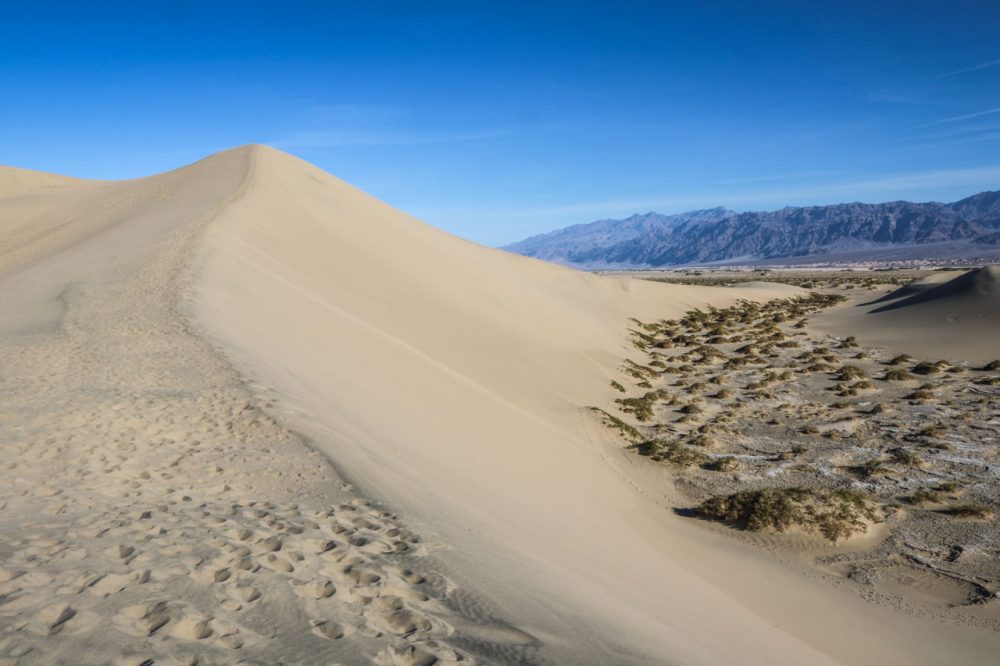
Sand dunes cover less than 1% of the surface area of Death Valley National Park, but are undoubtedly among the main sights in the park. This one percent is spread across five different dune areas, of which the Mesquite Flat Sand Dunes are the most well-known.
These also the most accessible sand dunes in the national park, situated just off of Highway 190, a couple of miles east of Stovepipe Wells.
The Mesquite Flat Sand Dunes are not the tallest dunes in Death Valley National Park, though. The tallest are the Eureka Dunes in the far north of the park, which are more than six times higher than the Mesquite Flat Sand Dunes.
Mesquite Flat does, however, encompass the largest and most easily accessible dune field in the park.
Consisting of three dune types—star, crescent and linear dunes—the Mesquite Flat Sand Dunes are a super-fun outdoor playground. Children and adults alike will have a blast exploring these hills of soft sand. There are some amazing views to be enjoyed here as well.
They are no official hiking trails, but you can explore as you please. Climbing the dunes, jumping, running and rolling down,… it’s all allowed and it’s so much fun. In terms of footwear, consider wearing closed hiking boots or simply going barefoot.
3. Badwater Basin
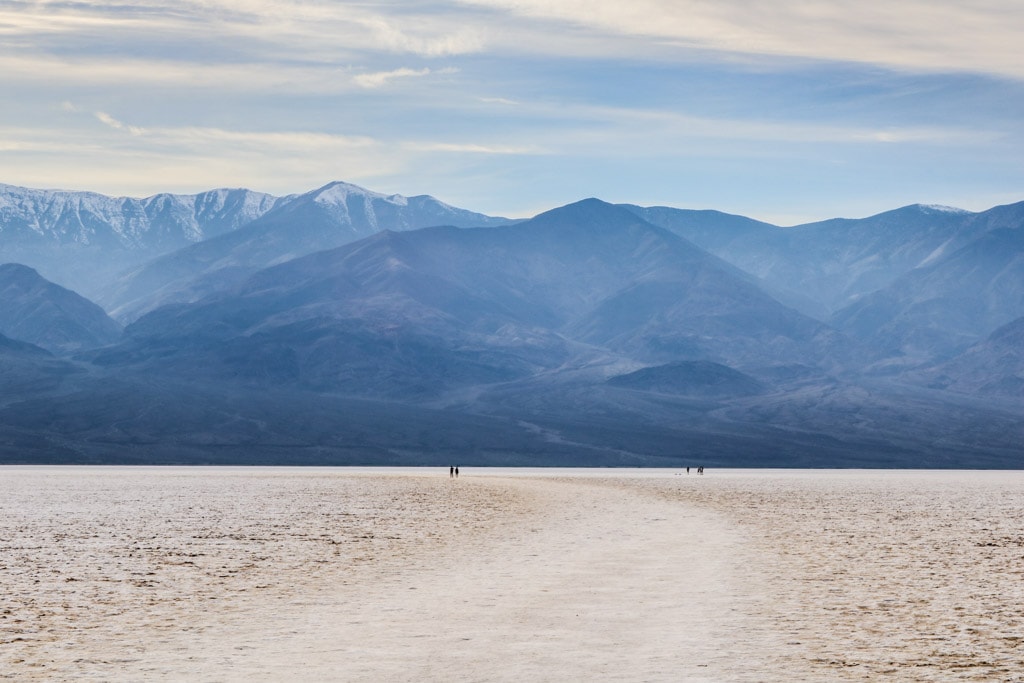
Badwater Basin encompasses North America’s lowest point, one of the many things that make Death Valley National Park so extraordinary.
Located 282 feet below sea level, you can get there on a short walk across the salt flats from the parking lot. It’s about 25 minutes by car from Furnace Creek.
Badwater Basin got its name from a small pool near the parking lot, named by a pioneer whose horse refused to drink the water. Although the water is extremely salty and undrinkable, there is some life in the pool, including water insects, pickleweed and the endemic Badwater snail.
When you walk across the salt flats to the lowest point, absolutely make sure to wear a hat and put some sunscreen on. It gets scorching hot and the white salt reflects the sun rays, doubling your chances to get sunburned.
Although Badwater Basin doesn’t have any panoramic views or main vantage points, the views across the flats, surrounded by towering mountains, are still pretty amazing. You can literally see for miles across this unique place in North America.
2. Dante’s View
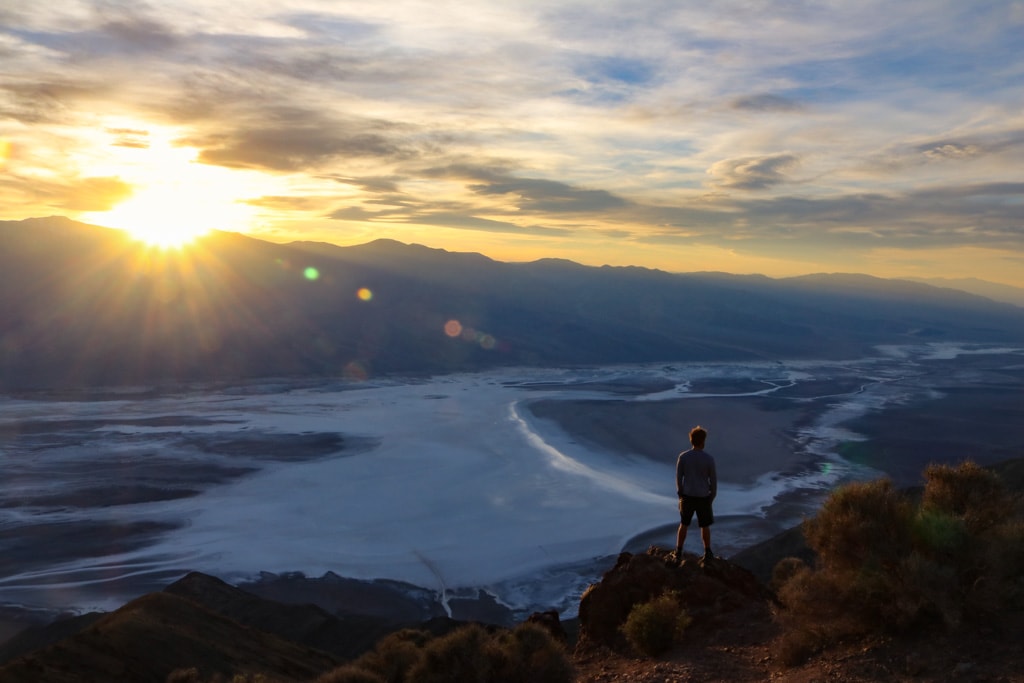
If things get too hot in the valley during the day—and they will—you can escape to the surrounding mountains. One of my favorite places to do that is Dante’s View, one of the most spectacular viewpoints in Death Valley National Park.
With an elevation of 5,476 feet above the valley, it’s much, much cooler up there. From Dante’s View, you’ll have a truly phenomenal view of Death Valley below and the Sierra Nevada Mountains in the distance.
What’s unique about this particular spot is that you can see both the lowest (Badwater – 282 feet below sea level) and highest (Mount Whitney – 14,505 feet) points in the contiguous United States at the same time.
1. Zabriskie Point

The golden rays of the early-morning or late-afternoon sun paint the badlands underneath Zabriskie Point all kinds of yellow, ocher and orange.
This is easily one of the best Death Valley sunrise spots, if not the best.
Zabriskie Point is a short drive southeast of Furnace Creek. Named after Christian Brevoort Zabriskie, the general manager of the early-1900s Pacific Coast Borax Company, the overlook offers spectacular panoramic views of the eroded landscape below.
Ocher-colored badlands stretch out before you in a sun-scorched maze of waves, canyons and gullies, while the Sierra Nevada mountains tower toward the sky in the far distance.
Although the panoramic view from Zabriskie Point is one of the major Death Valley National Park highlights, you’ll appreciate this remarkable landscape a lot more if you actually walk through it.
You can do that on the phenomenal Golden Canyon, Gower Gulch and Badlands Loop, which is about 8 miles long and runs deep into the badlands below. Shorter options are available on the Badlands Loop Trail.
More About Death Valley National Park
- Park Website
- Travel Guide
- Topographic Map
- Best Death Valley Hikes
- Things to Do Death Valley National Park
- Accommodation
Map of the Best Views in Death Valley National Park
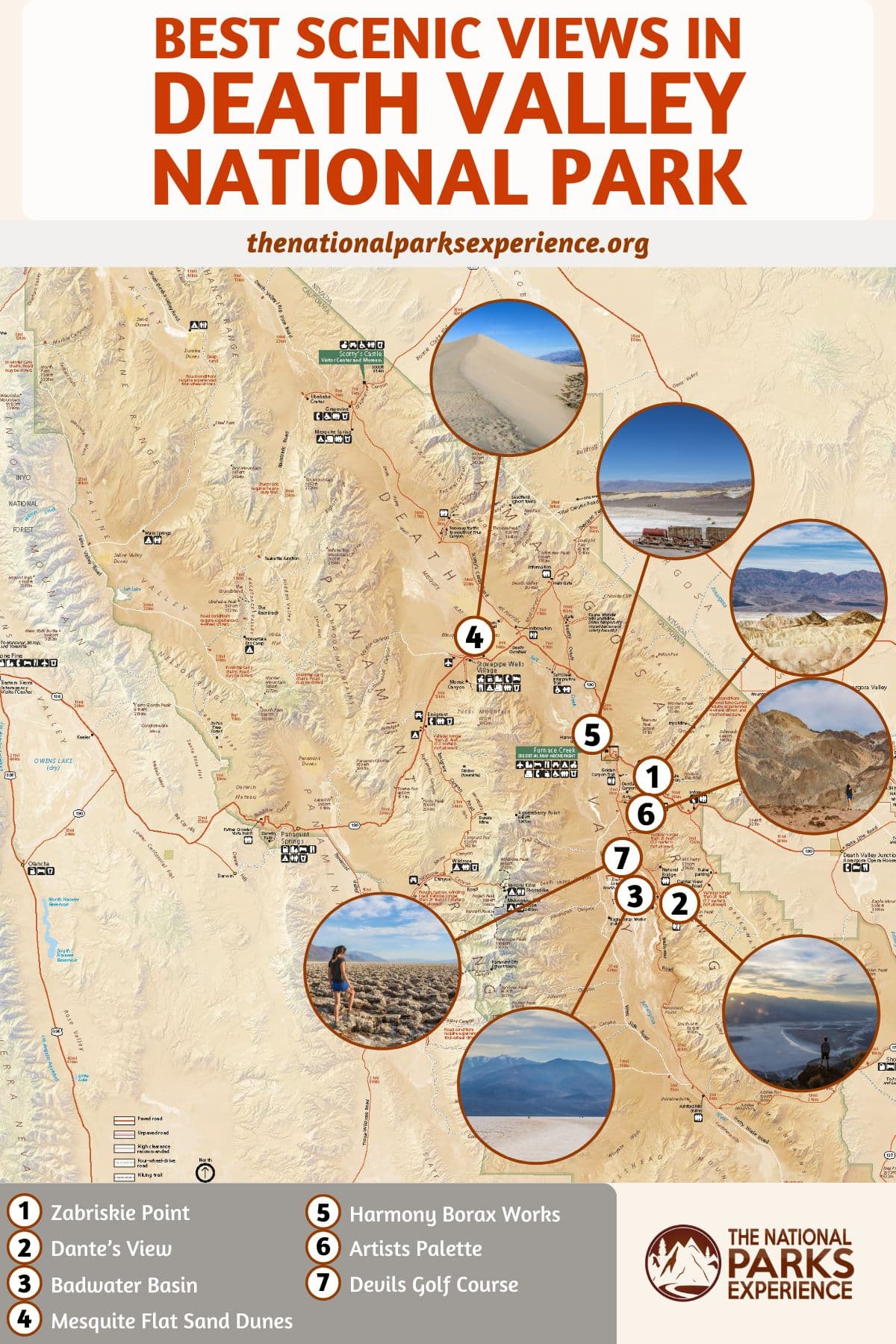
What Are You Favorite Views in Death Valley National Park? Share Your National Parks Experience Below!
More Scenic Views in the National Parks
- 12 Best Views of the Teton Range
- 5 Stunning Views of Crater Lake
- 10 Jaw-Dropping Views in Hawai’i Volcanoes National Park
- 20 Overlooks and Summits in Shenandoah National Park
- 12 Incredible Views in Acadia National Park
- 9 Best Places to See Mount Rainier in the National Park
- 10 Best Views in Zion National Park






